What is a Cast Iron Plant?
The Cast Iron Plant, also known as Aspidistra elatior, is a tough houseplant. It can grow well in many conditions. To keep it healthy, let the soil dry out before watering again. It prefers indirect or shaded light. Direct sunlight can harm its leaves. It comes from shaded rainforests in China and Japan. It loves low light, making it perfect for dark rooms. Its leaves can grow up to 2 feet long. To keep it happy, use well-draining soil. Don’t water too much to avoid root rot.History and Origin
The Cast Iron Plant was popular in the Victorian era. It thrived in low light, making it a favorite in homes. It’s still loved today.Characteristics of the Cast Iron Plant
This plant likes temperatures between 60-75 degrees Fahrenheit. It’s hardy in USDA Hardiness Zones 8-10. It prefers slightly acidic to neutral soil pH. By following these tips, you can enjoy a beautiful Cast Iron Plant at home.| Characteristics | Description |
|---|---|
| Temperature tolerance | 60-75 degrees Fahrenheit |
| Hardiness zones | USDA Hardiness Zones 8-10 |
| Soil pH preference | Slightly acidic to neutral |
Why Choose a Cast Iron Plant for Your Home?
Thinking about getting a new plant? The Cast Iron Plant is a great pick. It’s easy to care for and fits well in many homes. To keep your plant happy, use the right soil and follow a good guide. This plant loves low light, perfect for dark spots in your home. It also does well in medium to bright indirect light. Just make sure it’s not too close to windows to avoid burning.Low Maintenance Requirements
The Cast Iron Plant is great because it doesn’t need much water. Water it only when the soil feels dry, about every 1-2 weeks. This is perfect for people who forget to water their plants.Adaptability to Various Environments
This plant is also very flexible. It likes temperatures between 60-75°F and humidity of 40-50%. It’s perfect for homes with changing temperatures and humidity. Use the right soil and follow a good guide to help your plant thrive.Ideal Growing Conditions for Cast Iron Plants
To keep your Cast Iron Plant happy, you need to know what it likes. Start by checking how much light it needs. Cast Iron Plants do well in low to medium light. This makes them great for places with not much sunlight. Think about the temperature and humidity too. They like it between 60-75°F (16-24°C). They can handle different humidity levels. Knowing how to care for your Cast Iron Plant helps it grow well. Here are some important things to think about for your Cast Iron Plant:- Light Requirement: Medium to High Light; Low Light Tolerant
- Preferred Temperature: 60º – 75ºF (15-24ºC) during the day; Minimum night temperature: 50ºF (10ºC)
- Preferred Humidity: 40% – 50%
| Factor | Optimal Condition |
|---|---|
| Temperature | 60-75°F (16-24°C) |
| Humidity | 40% – 50% |
| Light | Medium to High Light; Low Light Tolerant |
Watering Your Cast Iron Plant
Watering your Cast Iron Plant is key. It only needs water when the soil is dry. This makes it easy to care for, even if you forget sometimes. Before you water, check the soil. Let the soil dry out completely between waterings. Use distilled water for the best results.Understanding Watering Needs
The Cast Iron Plant drinks most of its water through its roots. This means it likes dry soil. Too much water can cause root rot. Water it sparingly. If it’s in bright light, it might need more water. This helps avoid root rot. Here are some tips to keep in mind:- Water your Cast Iron Plant when the soil is dry to the touch
- Use distilled water to prevent mineral buildup
- Avoid getting water on the leaves to prevent fungal diseases
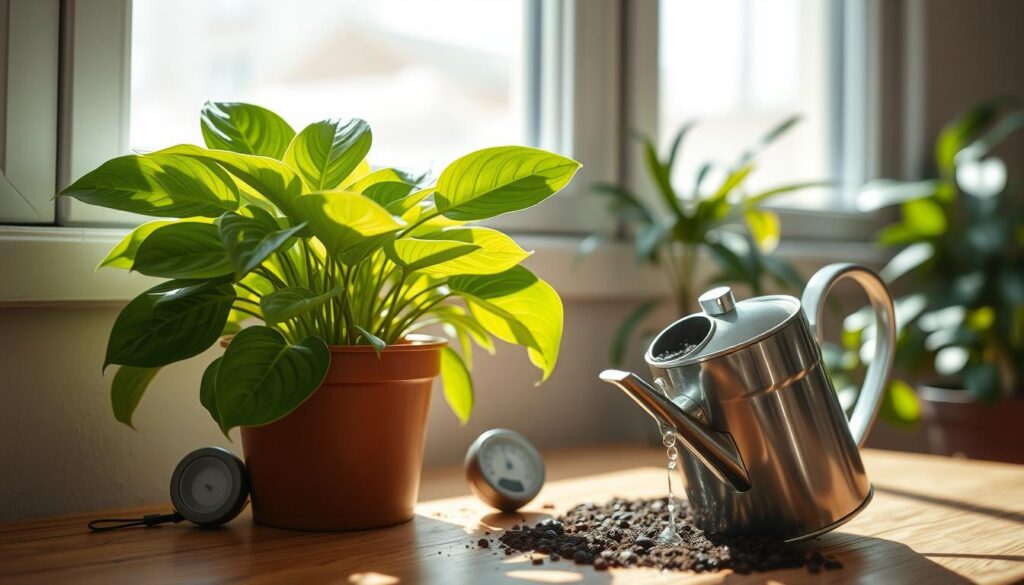 Follow these tips and consider the light it gets. This will help your plant do well. Watch your plant and change how often you water as needed.
Follow these tips and consider the light it gets. This will help your plant do well. Watch your plant and change how often you water as needed.
| Watering Frequency | Light Conditions |
|---|---|
| Every 9 days | Low light |
| Every 7 days | Medium light |
| Every 5 days | High light |
Feeding and Fertilizing Your Cast Iron Plant
To keep your Cast Iron Plant healthy, it needs the right food. Use fertilizing to give it what it needs. A balanced, water-soluble fertilizer is best. Fertilize twice a year, in spring and summer. When fertilizing Cast Iron Plant, use indoor plant fertilizer at half strength. This stops over-fertilizing. Here are some tips:- Use a balanced fertilizer with a ratio of 10-10-10 or 20-20-20.
- Fertilize your plant once a month during the growing season (spring and summer).
- For slow-release fertilizers, application may be necessary only once or twice per season.
| Fertilizer Type | Application Frequency |
|---|---|
| Balanced, water-soluble fertilizer | Twice a year (spring and summer) |
| Slow-release fertilizer | Once or twice per season |
Pruning and Grooming for Healthier Growth
Caring for your Cast Iron Plant means focusing on pruning and grooming. Regular pruning stops disease and helps growth. Start by removing damaged or dying leaves. This is key in troubleshooting Cast Iron Plant problems. Pruning needs the right tools and approach. Use clean, sharp scissors or pruning shears. Remove dead or damaged leaves first. Then, shape your plant to keep it the right size and shape.- Remove any damaged or dying leaves to prevent the spread of disease
- Use clean, sharp scissors or pruning shears to prevent spreading diseases
- Shape your plant to maintain its desired size and shape
Common Pests and Diseases Affecting Cast Iron Plants
When you care for Cast Iron Plants, knowing about pests and diseases is key. Regular checks and treatments stop disease spread. This keeps your plant healthy and growing well. A good guide on Cast Iron Plant care will talk about pest control and disease management. Pests like spider mites, mealybugs, and scale insects can harm your plant. They can make leaves turn yellow or brown. To avoid this, take good care of your plant. This includes watering and fertilizing right. A guide will tell you to watch for pests and diseases early. Root rot is a big problem for Cast Iron Plants. It happens when you water too much. This can kill the roots and harm the plant. To avoid root rot, follow a good guide on watering and soil care. This keeps your plant healthy and strong.Identifying Common Pests
- Spider mites: These tiny pests can cause yellowing or browning of leaves, and can be identified by fine webbing on the plant’s stems and leaves.
- Mealybugs: These small, white insects can be found on the plant’s stems and leaves, and can cause damage to the plant’s tissue.
- Scale insects: These small, armored insects can be found on the plant’s stems and leaves, and can cause damage to the plant’s tissue.
Treatment Options for Pests and Diseases
How you treat pests and diseases depends on the problem. For pests, insecticidal soap or horticultural oil works well. For diseases like root rot, change how you water and care for the soil. A detailed guide on Cast Iron Plant care helps prevent problems. This keeps your plant healthy and growing strong.Repotting Your Cast Iron Plant
As you care for your Cast Iron Plant, you’ll need to repot it soon. This is key for fresh soil and room to grow. Do it every 2-3 years or when it’s too tight in the pot. Pick a pot just a bit bigger and use soil that drains well to avoid soggy roots. Watch for signs like droopy leaves or roots poking out. Repotting at the right time stops root rot and diseases. For more on repotting, check out this guide. After repotting, adjust your fertilizing. Fertilizing Cast Iron Plant is key for growth. Use a balanced fertilizer when it’s growing. With these tips, your plant will look great and be easy to care for for years.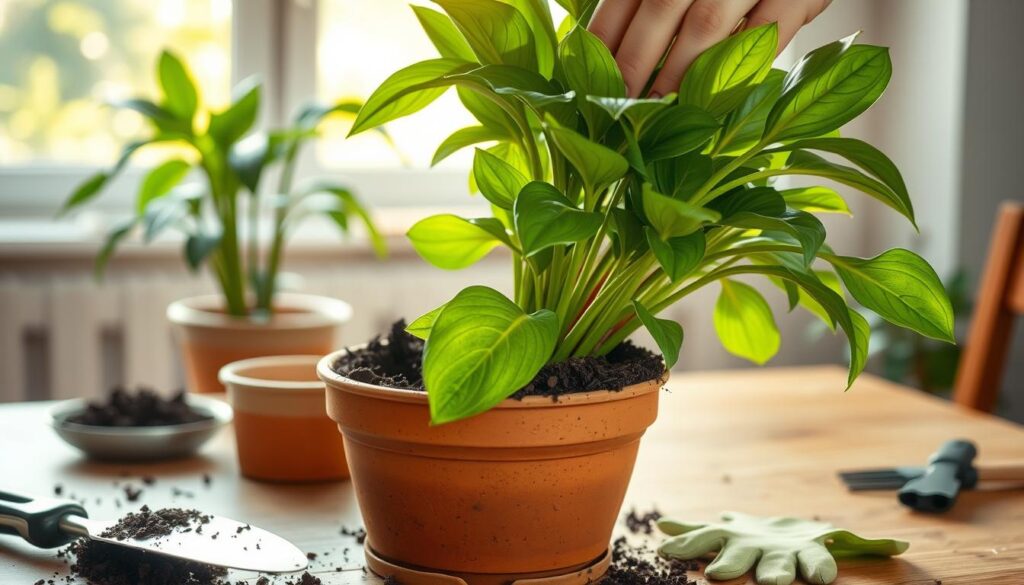 Here are some important tips for repotting your Cast Iron Plant:
* Pick a pot just a bit bigger
* Use soil that drains well
* Repot every 2-3 years or when it’s too tight
* Watch for signs like droopy leaves or roots poking out
By following these tips, your Cast Iron Plant will thrive. It will purify the air and look beautiful.
Here are some important tips for repotting your Cast Iron Plant:
* Pick a pot just a bit bigger
* Use soil that drains well
* Repot every 2-3 years or when it’s too tight
* Watch for signs like droopy leaves or roots poking out
By following these tips, your Cast Iron Plant will thrive. It will purify the air and look beautiful.
| Repotting Frequency | Soil Composition Ratio | Temperature Preferences |
|---|---|---|
| Every 2-3 years or when root-bound | 3:2:1 ratio of potting soil, coco coir, and perlite or pumice | 59-62.6°F (15-17°C) |
The Benefits of Having a Cast Iron Plant in Your Home
The Cast Iron Plant is easy to care for and fits well in many homes. It’s a natural air cleaner, removing bad stuff from the air. It also adds beauty and style to your home with its green leaves and small size.Air Purification Benefits
This plant is great at cleaning the air. It takes out bad stuff like formaldehyde and benzene. This makes your home air cleaner and healthier, especially in places with little fresh air.Aesthetic Appeal and Versatility
The Cast Iron Plant looks amazing in any room. It fits well with many styles, from modern to classic. You can put it on a shelf or a table, and it will make your home look better. If you are really in love with gardening see Michelles YouTube Channel for all things plants. If you would like to check out other resiliant low light houseplants, check out our article Here for 10 healthy low light plants for your indoor garden.FAQ
What is the history and origin of the Cast Iron Plant?
The Cast Iron Plant has a long history. It was loved in the Victorian era for indoor gardens. It comes from Asia, like Japan and China.
What are the characteristics of the Cast Iron Plant?
This plant has dark green leaves. It can grow up to 3 feet tall. It’s great for decorating indoors.
Why should I choose a Cast Iron Plant for my home?
These plants are easy to care for. They work well in many places. They’re perfect for people who are busy or new to gardening.
What are the ideal light conditions for a Cast Iron Plant?
They like low to medium light. This makes them perfect for places with little sunlight.
How often should I water my Cast Iron Plant?
Water it when the soil is dry. They can handle forgetting to water sometimes. But, too much water is bad.
How should I fertilize my Cast Iron Plant?
Use a balanced fertilizer. Fertilize twice a year, in spring and summer. This helps the plant grow well.
How do I prune and groom my Cast Iron Plant?
Pruning is key. It keeps the plant healthy and looking good. Remove any bad leaves to stop disease and help it grow.
What are some common pests and diseases that affect Cast Iron Plants?
They can get spider mites, mealybugs, and scale insects. Check often and treat quickly to keep the plant healthy.
When should I repot my Cast Iron Plant?
Repot every 2-3 years or when it needs more room. This gives it fresh soil and space to grow.
What are the benefits of having a Cast Iron Plant in my home?
They are easy to care for and clean the air. They also make any room look better.


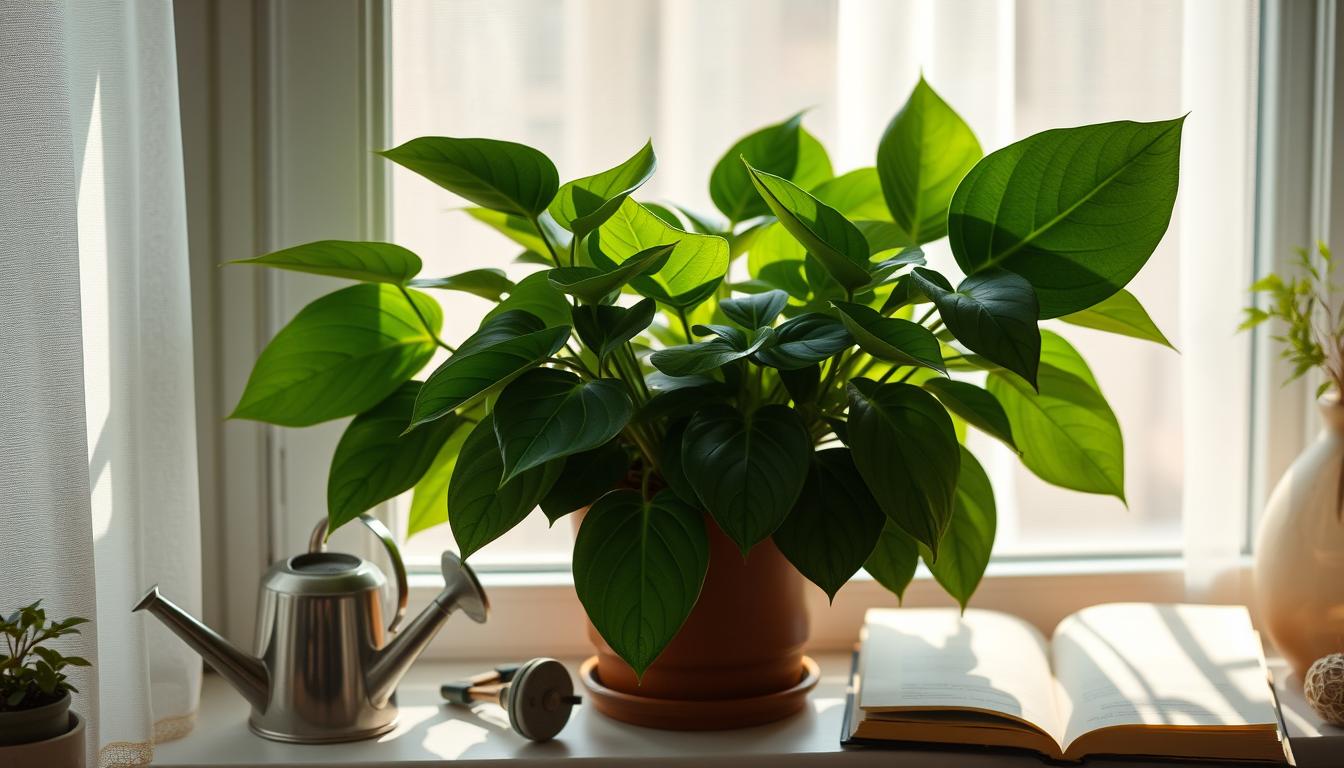
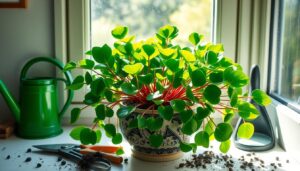
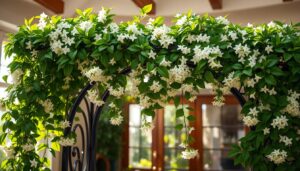
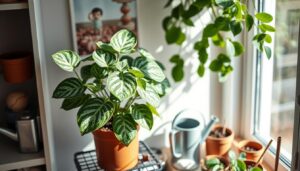
Pingback: The Ultimate Guide to Houseplants: 100 Best Indoor Plants for Every Home - Trusted House Plant Guide